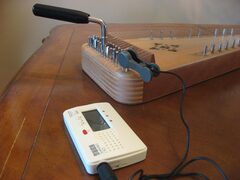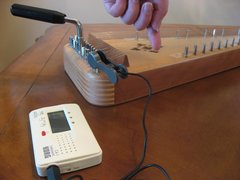A Free Article on How to Tune Your Bowed Psaltery
Below is a free article on how to tune a Bowed Psaltery.
For more information on how to play the Bowed Psaltery, see the book:
Tuning a Bowed Psaltery by Ann Tucker
If you are like most hobby musician, you can hear when an instrument is off, but you can’t figure out how get it back in tune.

There are plenty of inexpensive (about US$20) electronic tuners available. They can be found with and without a clip on pick-up microphone. Ones without a clip on, measure the sound waves in the air. This works fine if you tune your instrument in a quiet area. However, if the dog’s barking, you will get to see what note he barks at.
The electronic tuner with a clip on pickup (as shown above) only hears the sounds coming from your instrument. This makes it much easier to get a good reading on the note. You may find that you have to move the pickup as you tune different strings to keep it from being in your way.
Once you have the tuner hooked up and turned on, you are ready to start tuning.
Start with the longest string on the right side of the instrument. The longer strings are a bit more forgiving on tuning adjustments. So they are a good place to start and gain confidence in tuning.
Run you finger down the string to find where it ends on a tuning pin. Place the tuning wrench down over this pin. Then pluck the string.
Do not pluck it too close to either end as the string will not vibrate as well as it could for tuning. The photo below shows a nice distance from the tuning pins at the bottom of the Bowed Psaltery.

The tuner will display a letter for the sound made and whether it is too sharp or too flat.
If the sound it too flat, turn the wrench a tiny bit in the direction of winding more string onto the pin. This will tighten the string. If the note is too sharp, loosen the string. Do this for each string on the instrument.

When tightening and loosening a string, rotate the wrench a very small tiny bit at a time.
Depending on the string, a turn from the 3 o’clock position to the 6 o’clock position could take the string to the next note.
************************************
If you'd like more information on the book, Playing the Bowed Psaltery, A Step by Step Beginner’s Guide, please send me a note below.
Thanks for stopping by!
Ann

